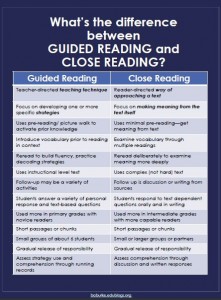I have observed a lot of confusion about close reading and guided reading. I’ve even heard some educators using those terms interchangeably. Nothing could be further from the truth! These two terms reflect reading practices that both have their place in elementary classrooms, but teachers have to carefully consider the reasons for selecting either.
 Guided reading is a specific teaching technique– a method that a teacher uses to guide students to learn to master specific strategies for unlocking text. It was perfected by Irene Fountas and Gay Su Pinnell in the 1990’s. Students begin at very basic level texts that are highly supportive for readers—excellent picture clues and mostly decodable text. The teacher selects a “just right” text for a group of 4-6 students. The teacher models and guides students through activating prior knowledge and pre-reading activities, such as a picture walk. Students are guided in applying strategies before, during, and after reading. The text is often chunked into small pieces (a page or two). During and after reading, the teacher asks questions that relate to the story. Often, the teacher takes a running record of a student as he/she reads. Students may reread a text more than once to build fluency and practice decoding skills. Students may do a variety of follow-up activities, such as “copy cat” books, word sorts, or some writing.
Guided reading is a specific teaching technique– a method that a teacher uses to guide students to learn to master specific strategies for unlocking text. It was perfected by Irene Fountas and Gay Su Pinnell in the 1990’s. Students begin at very basic level texts that are highly supportive for readers—excellent picture clues and mostly decodable text. The teacher selects a “just right” text for a group of 4-6 students. The teacher models and guides students through activating prior knowledge and pre-reading activities, such as a picture walk. Students are guided in applying strategies before, during, and after reading. The text is often chunked into small pieces (a page or two). During and after reading, the teacher asks questions that relate to the story. Often, the teacher takes a running record of a student as he/she reads. Students may reread a text more than once to build fluency and practice decoding skills. Students may do a variety of follow-up activities, such as “copy cat” books, word sorts, or some writing.
What makes close reading different? First of all, it is not a teaching method. Close reading is a goal for proficient readers. Close reading has been around much longer than Guided Reading—it originates back in the 1920’s, and was really popular in the 40’s and 50’s. Close reading focuses on gleaning meaning from the text itself—what the author is trying to say. To facilitate a close reading, the teacher does just enough pre-reading activities to get students ready to understand the text. Students dive in, reading the text in chunks. The text isn’t selected based on readability, but rather on the complexity of the ideas to explore. You don’t read an entire book or article closely—you select smaller portions that you want to dig into more deeply. After reading, students discuss the text, asking and answering text dependent questions that require the reader to revisit the text. Students reread the text several times, digging deeper into the complexity of the message each time.
So…what should you be doing with your students: guided or close reading? The answer is both, or either. Each time you meet with a small group, you need to make decisions, including how to best approach the text in order to meet the needs of this group of students. Guide readers who are just learning to read. Facilitate close reading when students need to read to learn and deeply comprehend text.
Download the infographic here.